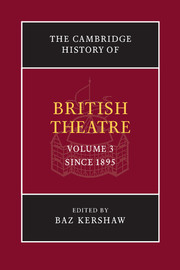Book contents
- Frontmatter
- Part I 1895–1946
- Part II Scottish and Welsh Theatres, 1895–2002
- Part III 1940–2002
- 13 British theatre, 1940–2002: an introduction
- 14 The establishment of mainstream theatre, 1946–1979
- 15 Alternative theatres, 1946–2000
- 16 Developments in the profession of theatre, 1946–2000
- 17 Case study: Theatre Workshop’s Oh What a Lovely War, 1963
- 18 1979 and after: a view
- 19 British theatre and commerce, 1979–2000
- 20 New theatre for new times: decentralisation, innovation and pluralism, 1975–2000
- 21 Theatre in Scotland in the 1990s and beyond
- 22 Theatre in Wales in the 1990s and beyond
- 23 English theatre in the 1990s and beyond
- Bibliography
- Index
- References
15 - Alternative theatres, 1946–2000
from Part III - 1940–2002
Published online by Cambridge University Press: 28 March 2008
- Frontmatter
- Part I 1895–1946
- Part II Scottish and Welsh Theatres, 1895–2002
- Part III 1940–2002
- 13 British theatre, 1940–2002: an introduction
- 14 The establishment of mainstream theatre, 1946–1979
- 15 Alternative theatres, 1946–2000
- 16 Developments in the profession of theatre, 1946–2000
- 17 Case study: Theatre Workshop’s Oh What a Lovely War, 1963
- 18 1979 and after: a view
- 19 British theatre and commerce, 1979–2000
- 20 New theatre for new times: decentralisation, innovation and pluralism, 1975–2000
- 21 Theatre in Scotland in the 1990s and beyond
- 22 Theatre in Wales in the 1990s and beyond
- 23 English theatre in the 1990s and beyond
- Bibliography
- Index
- References
Summary
British alternative theatre in the post-World War Two period was, in part, a reaction to ‘mainstream theatre’. Of course the ‘mainstream’ evolved during those turbulent decades, so that the types of theatre that might be counted as part of it varied, but overall it consisted of West End commercial theatre and commercial venues of the regional touring circuits, subsidised regional repertory theatres and other municipal theatres, and the national theatres (Royal National Theatre, Royal Shakespeare Company). Yet the contrast between ‘alternative’ and ‘mainstream’, in practice, has rarely been that straightforward.
For example, when the National Theatre staged Howard Brenton’s Romans in Britain in 1980 it produced a significant ‘alternative’ in relation to both mainstream and alternative theatre repertoires of the time. Aesthetically, no alternative company could have matched its scenographic scale and complexity; politically, few other mainstream theatres would have dared to take the legal risks involved in its explicit portrayal of buggery as a metaphor for the British occupation of Northern Ireland. The example underlines the fact that relativity, in art as much as in physics, gradually became a condition of twentieth-century global culture, so that contesting binary opposites – male–female, centre–margins, mainstream–alternative and more – gave way to a plethora of possible performance practices and analytical perspectives. Accordingly, between World War Two and the turn of the millennium British theatre as a whole increasingly became pluralistic and fragmented. So as well as considering the complexities of a growing variety of alternative theatres in the second half of the twentieth century, this chapter aims to suggest the historiographic difficulties in such a task.
- Type
- Chapter
- Information
- The Cambridge History of British Theatre , pp. 349 - 376Publisher: Cambridge University PressPrint publication year: 2004
References
- 3
- Cited by

